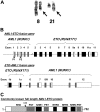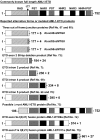Acute myeloid leukemia with the 8q22;21q22 translocation: secondary mutational events and alternative t(8;21) transcripts
- PMID: 17412887
- PMCID: PMC1924771
- DOI: 10.1182/blood-2006-11-019265
Acute myeloid leukemia with the 8q22;21q22 translocation: secondary mutational events and alternative t(8;21) transcripts
Abstract
Nonrandom and somatically acquired chromosomal translocations can be identified in nearly 50% of human acute myeloid leukemias. One common chromosomal translocation in this disease is the 8q22;21q22 translocation. It involves the AML1 (RUNX1) gene on chromosome 21 and the ETO (MTG8, RUNX1T1) gene on chromosome 8 generating the AML1-ETO fusion proteins. In this review, we survey recent advances made involving secondary mutational events and alternative t(8;21) transcripts in relation to understanding AML1-ETO leukemogenesis.
Figures



References
-
- Rowley JD. Identificaton of a translocation with quinacrine fluorescence in a patient with acute leukemia. Ann Genet. 1973;16:109–112. - PubMed
-
- Groupe Français de Cytogénétique Hématologique. Acute myelogenous leukemia with an 8;21translocation. A report on 148 cases from the Groupe Francais de Cytogenetique Hematologique. Cancer Genet Cytogenet. 1990;44:169–179. - PubMed
-
- Lai YY, Qiu JY, Jiang B, et al. Characteristics and prognostic factors of acute myeloid leukemia with t (8; 21) (q22; q22). Zhongguo Shi Yan Xue Ye Xue Za Zhi. 2005;13:733–740. - PubMed
-
- Erickson P, Gao J, Chang KS, et al. Identification of breakpoints in t(8;21) acute myelogenous leukemia and isolation of a fusion transcript, AML1/ETO, with similarity to Drosophila segmentation gene, runt. Blood. 1992;80:1825–1831. - PubMed
Publication types
MeSH terms
Substances
Grants and funding
LinkOut - more resources
Full Text Sources
Medical

